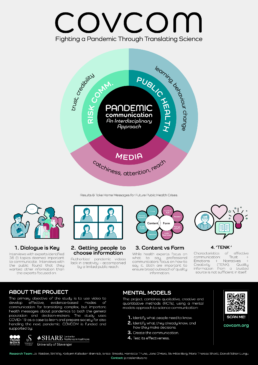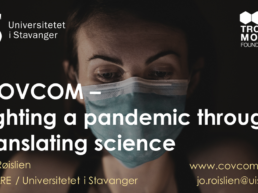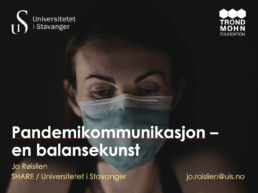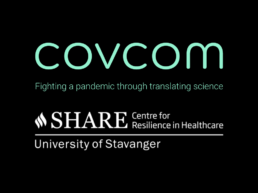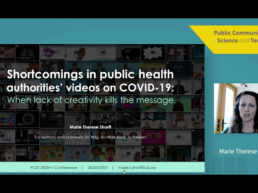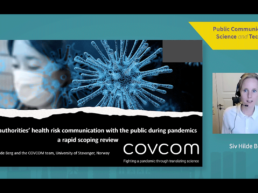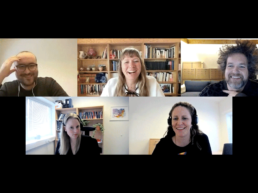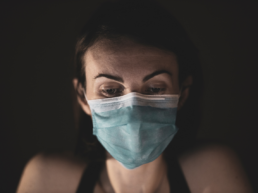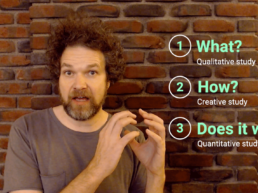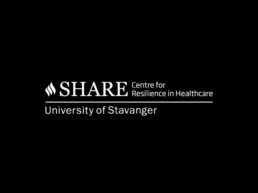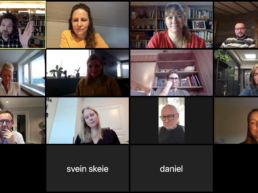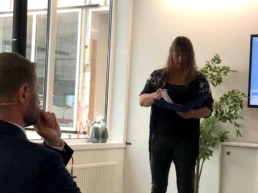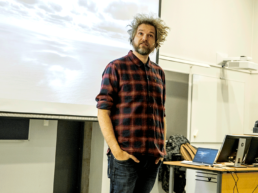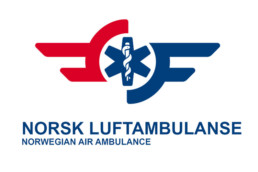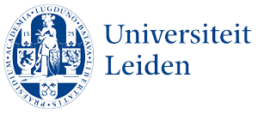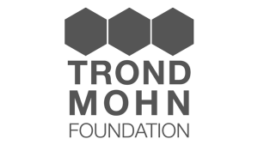Fighting a pandemic through translating science
Fighting a pandemic through translating science
Aim & Objectives
The primary objective of the study is to use video to develop effective, evidence-based modes of communication for translating complex, but important health messages about pandemics to both the general population and decision-makers. The study uses COVID-19 as a case to learn and prepare society for also handling the next pandemic.
Establish the key scientific concepts
Identify key scientific concepts about pandemics that the public health scientists and officials need to communicate. Review existing evidence on effective mass communication of pandemic information.
Explore artistic choices and modes of communication
Explore development and communication strategies for effective science communication, and the artistic dimensions in filmmaking for the creation of effective science communication videos for the lay viewer.
Scientific experiments
Assess the effect of various communication modes in a series of large scale randomized experiments, coupling communication to comprehension, trust, intentions, and behaviour, exploring also sociodemographic variables.
In the Media
Presentations
by COVCOM
8 September 2022
Røislien presents the COVCOM project at the Research Council of Norway conference
COVCOM was part of a select few projects presented at the COVID-19: Research in the wake of the pandemic final conference.
18 May 2022
Røislien presented results from the COVCOM project at the Norwegian Academy of Science and Letters
How do you communicate during a pandemic? During the academy's seminar about pandemics, Jo Røislien gave a presentation about the research project COVCOM.
6 December 2021
Postdoctor Siv Hilde Berg presents COVCOM at Citizen Science Seminar
Berg presented: Involving the public and experts in creating pandemic health communication at the Citizen Science seminar at the University of Stavanger 6 December 2021.
25 November 2021
COVCOM Team Present at International Symposium for Early Career Research in Quality and Safety in Healthcare
Postdocs Marie Therese Shortt, Daniel Adrian Lungu and Siv Hilde Berg presented results from recent studies.
27 October 2021
Røislien presents COVCOM at Stiftelsen Norsk Luftambulanse
Project leader Jo Røislien presented the COVCOM project and discussed the challenge in reaching out with important health information on a large scale during high risk situations.
16 October 2021
Røislien presents the COVCOM project at Data-SKUP Conference
Project leader Jo Røislien presented the COVCOM project and recent research finding from the project.
21 September 2021
Røislien presents COVCOM at Healthy Choices seminar (UiT)
Røislien presented the COVCOM project at the University of Tromsø for the Healthy Choices seminar.
26 May 2021
Shortt presents at PCST 2020+1 Conference
Our Postdoc Marie Therese Shortt presented insights from her research 'Shortcomings in public health authorities' videos on COVID-19: When lack of creativity kills the message' at the Public Communication of Science and Technology Conference 2020+1.
24 May 2021
Berg presents at PCST 2020+1 Conference
Our Postdoc Siv Hilde Berg presented insights from 'Health authorities' health risk communication with the public during pandemics: a rapid scoping review' at the Public Communication of Science and Technology Conference 2020+1.
10 March 2021
COVCOM workshop at Trust Me! Conference
On March 9th 2021, the COVCOM team contributed with a 90 minute workshop for the Trust Me! Conference by Linnaus University.
1 March 2021
Røislien presents COVCOM at International Research Conference
Jo Røislien presented 'Covid-19 and science communication -- lessons learned' at the international research conference 'The Contribution of RNAi to Sustainable and Resilient Food Systems & Health'.
18 December 2020
Røislien presents COVCOM at Research Council of Norway seminar
Jo Røislien presented the COVCOM project during the seminar 'Public Health Response and Social Countermeasures'
13 December 2020
Røislien presents COVCOM for SHARE board
December 12th project manager Jo Røislien presented the COVCOM project for an enthusiastic SHARE board.
23 November 2020
COVCOM Kick-Off
Friday 20th November we had the official launch of the COVCOM project. Partners joined us from far afield in Norway and abroad – from Denmark, to the UK and Australia.
15 October 2020
Thune presents COVCOM for the Minister of Health
Dean of Research at the Faculty of Health Sciences, UiS, and COVCOM co-lead, Henriette Thune, had the opportunity to present COVCOM to the Norwegian Minister of Health and Care, Bent Høie, during his visit to Stavanger on 25th September.
20 August 2020
Røislien presents COVCOM at the Norwegian Institute of Public Health (FHI)
In August our project leader Jo Røislien had the opportunity to present the COVCOM project at the Norwegian Institute of Public Health (FHI).
Publications
Assessing the Effect of Nonvisual Information Factors in Pandemic-Related Video Communication: Randomized Controlled Between-Subjects Experiment
Daniel Adrian Lungu, Jo Røislien, Siv Hilde Berg, Ionica Smeets, Marie Therese Shortt, Henriette Thune, Kolbjørn K. Brønnick
Journal of Medical Internet Research.2023;Volum 25.(1). DOI: 10.2196/42528
ABSTRACT
Background: Humans have fundamental difficulties to grasp the extent of exponential growth, which is fundamental to grasp the extent of a spreading infectious disease. Exponential growth bias is the pervasive tendency to linearize exponential functions when assessing them intuitively.
Objective: This systematic review aims to identify, evaluate and synthesise the findings of empirical studies concerning exponential growth bias of infectious diseases
Methods: A systematic review will be conducted using the preferred reporting items for systematic review and meta-analysis protocols (PRISMA-P) 2015 statement. Risk of bias will be assessed using ROBINS-2 and STROBE. Data synthesis will be achieved through a narrative synthesis
Results: As of February 2022, we included 11 studies, see PRISMA flow diagram, figure 1. This comprises 10 quasi-experimental studies and one cross sectional survey study. Preliminary themes identified are: The presence and effect of EGB of infectious diseases, visual and educational strategies to mitigate EGB of infectious diseases. Data extraction, narrative synthesis and risk of bias assessment will be expected to be due June 2022.
Conclusions: This systematic review concludes on limitation of the research and drawing some lines related to how people comprehend and misperceive exponential growth and its’ consequences for mitigating infectious diseases. Furthermore, the study will give recommendations for communication of exponential growth of infectious diseases and suggestion for future research.
Key topics in pandemic health risk communication: A qualitative study of expert opinions and knowledge
Siv Hilde Berg, Marie Therese Shortt, Jo Røislien, Daniel Adrian Lungu, Henriette Thune, Siri Wiig
PLOS ONE. 2022; 17(9). DOI: 10.1371/journal.pone.0275316
ABSTRACT
Background: Science communication can provide people with more accurate information on pandemic health risks by translating complex scientific topics into language that helps people make more informed choices on how to protect themselves and others. During pandemics, experts in medicine, science, public health, and communication are important sources of knowledge for science communication. This study uses the COVID-19 pandemic to explore these experts’ opinions and knowledge of what to communicate to the public during a pandemic. The research question is: What are the key topics to communicate to the public about health risks during a pandemic?
Method: We purposively sampled 13 experts in medicine, science, public health, and communication for individual interviews, with a range of different types of knowledge of COVID-19 risk and communication at the national, regional and hospital levels in Norway. The interview transcripts were coded and analysed inductively in a qualitative thematic analysis.
Results: The study’s findings emphasise three central topics pertaining to communication about pandemic health risk during the first year of the COVID-19 pandemic in Norway: 1) how the virus enters the human body and generates disease; 2) how to protect oneself and others from being infected; and 3) pandemic health risk for the individual and the society.
Conclusion: The key topics emerging from the expert interviews relate to concepts originating from multiple disciplinary fields, and can inform frameworks for interprofessional communication about health risks during a pandemic. The study highlights the complexity of communicating pandemic messages, due to scientific uncertainty, fear of risk amplification, and heterogeneity in public health and scientific literacy. The study contributes with insight into the complex communication processes of pandemic health risk communication.
Differences in comprehending and acting on pandemic health risk information: a qualitative study using mental models.
Siv Hilde Berg, Marie Therese Shortt, Henriette Thune, Jo Røislien, Jane O’Hara, Daniel Adrian Lungu, Siri Wiig
BMC Public Health, 2022; 22, 1440. DOI: https://doi.org/10.1186/s12889-022-13853-y
ABSTRACT
Background: A worldwide pandemic of a new and unknown virus is characterised by scientific uncertainty. However, despite this uncertainty, health authorities must still communicate complex health risk information to the public. The mental models approach to risk communication describes how people perceive and make decisions about complex risks, with the aim of identifying decision-relevant information that can be incorporated into risk communication interventions. This study explored how people use mental models to make sense of scientific information and apply it to their lives and behaviour in the context of COVID-19.
Methods: This qualitative study enrolled 15 male and female participants of different ages, with different levels of education and occupational backgrounds and from different geographical regions of Norway. The participants were interviewed individually, and the interview data were subjected to thematic analysis. The interview data were compared to a expert model of COVID-19 health risk communication based on online information from the Norwegian Institute of Public Health. Materials in the interview data not represented by expert model codes were coded inductively. The participants’ perceptions of and behaviours related to health risk information were analysed across three themes: virus transmission, risk mitigation and consequences of COVID-19.
Results: The results indicate that people placed different meanings on the medical and scientific words used by experts to explain the pandemic (e.g., virus transmission and the reproduction number). While some people wanted to understand why certain behaviour and activities were considered high risk, others preferred simple, clear messages explaining what to do and how to protect themselves. Similarly, information about health consequences produced panic in some interviewees and awareness in others.
Conclusion: There is no one-size-fits-all approach to public health risk communication. Empowering people with decision-relevant information necessitates targeted and balanced risk communication.
Exponential growth bias of infectious diseases: A systematic review protocol
Siv Hilde Berg, Daniel Adrian Lungu, Kolbjørn K. Brønnick, Stig Harthug, Jo Røislien
JMIR Res Protoc. 2022.11 (10): e37441. DOI: 10.2196/37441
ABSTRACT
Background: Humans struggle to grasp the extent of exponential growth, which is essential to comprehend the spread of an infectious disease. Exponential growth bias is the tendency to linearize exponential functions when assessing them intuitively. Effective public health communication about the nonlinear nature of infectious diseases has strong implications for the public’s compliance with strict restrictions. However, there is a lack of synthesized knowledge on the communication of the exponential growth of infectious diseases and on the outcomes of exponential growth bias.
Objective: This systematic review identifies, evaluates, and synthesizes the findings of empirical studies on exponential growth bias of infectious diseases.
Methods: A systematic review will be conducted using the PRISMA-P (Preferred Reporting Items for Systematic Review and Meta-Analysis Protocols) 2015 statement. Eligibility criteria include empirical studies of exponential growth bias of infectious diseases regardless of methodology. We include studies both with and without interventions/strategies. For information sources, we include the following five bibliographic databases: MEDLINE, Embase, Cochrane Library, PsychINFO, and Web of Science Core Collection. The risk of bias will be assessed using RoB 2 (Risk of Bias 2) and STROBE (Strengthening the Reporting of Observational Studies in Epidemiology). Data synthesis will be achieved through a narrative synthesis.
Results: By February 2022, we included 11 experimental studies and 1 cross-sectional survey study. Preliminary themes identified are the presence of exponential growth bias, the effect of exponential growth bias, and communication strategies to mitigate exponential growth bias. Data extraction, narrative synthesis, and the risk of bias assessment are to be completed by February 2023.
Conclusions: We anticipate that this systematic review will draw some lines related to how people comprehend and misperceive exponential growth and its consequences for infectious disease mitigation and communication. Furthermore, the study will conclude with the limitations of the research and suggestions for future research.
Exploring health experts’ and creative communicators’ focus in pandemic video communication: A qualitative study
Marie Therese Shortt, Siv Hilde Berg, Siri Wiig, Daniel Adrian Lungu, Ionica Smeets, Henriette Thune and Jo Røislien
Front. Commun. 30 May 2022; 7:886768. doi: 10.3389/fcomm.2022.886768
ABSTRACT
Pandemic video communication aimed at the general public often lacks creativity and fails to reach large audiences. Yet, the scientific content should not be compromised by attempts to improve the creativity or reach. This study explores the processes utilised by various health experts and professional communicators when creating communication, to identify similarities and differences, and how pandemic video communication thus can be improved through an interdisciplinary approach. We interviewed 12 individuals from 6 different professional domains: health, public health, film/science communication, video journalism, advertising, and social media/YouTube. Semi-structured individual interviews were conducted using the same interview guide. The interview data were subjected to thematic analysis with both deductive and inductive coding, and the results were visualised in a bubble chart. Our study has highlighted both similarities and differences between health professionals and creative communicators relating to their creative processes and their approaches to pandemic video communication. We found that participants from health domains assigned great importance to and efforts on the content, but were unsure or lacked experience in how content is translated through form and creativity. Creative communicators, on the other hand, emphasise and specialise in form, yet depend on health professionals, experts, and scientists to provide and validate content. The key to improving pandemic-related video communication appears to lie in striking the right balance between high-quality and evidence-based content and creativity. This study found that both health professionals and creative communicators play crucial roles in reaching a solid end result, and we suggest a fusion model approach to interdisciplinary collaboration.
Creating Effective, Evidence-Based Video Communication of Public Health Science (COVCOM Study): Protocol for a Sequential Mixed Methods Effect Study
Jo Røislien, Jane O’Hara, Ionica Smeets, Kolbjørn Brønnick, Siv Hilde Berg, Marie Therese Shortt, Daniel Adrian Lungu, Henriette Thune, Siri Wiig
JMIR Res Protoc. 2022 Mar 11;11(3):e34275. doi: 10.2196/34275
ABSTRACT
Background: The nonlinear nature of contagious diseases and the potential for exponential growth can be difficult to grasp for the general public. This has strong implications for public health communication, which needs to be both easily accessible and efficient. A pandemic is an extreme situation, and the accompanying strict societal measures are generally easier to accept if one understands the underlying reasoning behind them. Bringing about informed attitude change and achieving compliance to strict restrictions requires explanations of scientific concepts and terminologies that laypersons can understand.
Objective: The aim of the project is to develop effective, evidence-based modes of video communication for translating complex, but important, health messages about pandemics to both the general population and decision makers. The study uses COVID-19 as a case to learn and prepare society for handling the ongoing and future pandemics, as well as to provide evidence-based tools for the science communication toolbox.
Methods: The project applies a mixed methods design, combining qualitative methods (eg, interviews, observational studies, literature reviews) and quantitative methods (eg, randomized controlled trials [RCTs]). The project brings together researchers from a wide range of academic fields, as well as communication industry professionals.
Results: This study has received funding from the Trond Mohn Foundation through the Research Council of Norway’s “COVID-19 Emergency Call for Proposals” March 2020. Recruitment and data collection for the exploratory first phase of the project ran from February 2021 to March 2021. Creative communication work started in May 2021, and the production of videos for use in the RCTs in the final phase of the project started in September 2021.
Conclusions: The COVCOM project will take on several grand challenges within the field of communicating science and provide evidence-based tools to the science communication toolbox. A long-term goal of the project is to contribute to the creation of a more resilient health care system by developing communication responses tailormade for different audiences, preparing society for any future pandemic.
The role of recipients’ characteristics in health video communication outcomes: a scoping review
Daniel Adrian Lungu, Jo Røislien, Siri Wiig, Marie Therese Shortt, Francesca Ferrè, Siv Hilde Berg, Henriette Thune, Kolbjørn Kallesten Brønnick
J Med Internet Res. 2021 Dec 30;23(12):e30962. doi: 10.2196/30962
ABSTRACT
Background: The importance of effective communication during public health emergencies has been highlighted by the World Health Organization, and it has published guidelines for effective communication in such situations. With video being a popular medium, video communication has been a growing area of study over the past decades and is increasingly used across different sectors and disciplines, including health. Health-related video communication gained momentum during the SARS-CoV-2 pandemic, and video was among the most frequently used modes of communication worldwide. However, although much research has been done regarding different characteristics of video content (the message) and its delivery (the messenger), there is a lack of knowledge about the role played by the characteristics of the recipients for the creation of effective communication.
Objective: The aim of this review is to identify how health video communication outcomes are shaped by recipient characteristics, as such characteristics might affect the effectiveness of communication. The main research question of the study is as follows: do the characteristics of the recipients of health videos affect the outcomes of the communication?
Methods: A scoping review describing the existing knowledge within the field was conducted. We searched for literature in 3 databases (PubMed, Scopus, and Embase) and defined eligibility criteria based on the relevance to the research question. Recipient characteristics and health video communication outcomes were identified and classified.
Results: Of the 1040 documents initially identified, 128 (12.31%) met the criteria for full-text assessment, and 39 (3.75%) met the inclusion criteria. The included studies reported 56 recipient characteristics and 42 communication outcomes. The reported associations between characteristics and outcomes were identified, and the potential research opportunities were discussed. Contributions were made to theory development by amending the existing framework of the Integrated-Change model, which is an integrated model of motivational and behavioral change.
Conclusions: Although several recipient characteristics and health video communication outcomes were identified, there is a lack of robust empirical evidence on the association between them. Further research is needed to understand how the preceding characteristics of the recipients might affect the various outcomes of health video communication.
Shortcomings in public health authorities’ videos on COVID-19: limited reach and a creative gap
Marie Therese Shortt, Ionica Smeets, Siri Wiig, Siv Hilde Berg, Daniel Adrian Lungu, Henriette Thune, Jo Røislien
Front. Commun., 23 December 2021 doi: 10.3389/fcomm.2021.764220
ABSTRACT
Video communication has played a key role in relaying important and complex information on the COVID-19 pandemic to the general public. The aim of the present study is to compare Norwegian health authorities’ and WHO’s use of video communication during the COVID-19 pandemic to the most viewed COVID-19 videos on YouTube, in order to identify how videos created by health authorities measure up to contemporary video content, both creatively and in reaching video consumers. Through structured search on YouTube we found that Norwegian health authorities have published 26 videos, and the WHO 29 videos on the platform. Press briefings, live videos, news reports, and videos recreated/translated into other languages than English or Norwegian, were not included. A content analysis comparing the 55 videos by the health authorities to the 27 most viewed videos on COVID-19 on YouTube demonstrates poor reach of health authorities’ videos in terms of views and it elucidates a clear creative gap. While the videos created by various YouTube creators communicate using a wide range of creative presentation means (such as professional presenters, contextual backgrounds, advanced graphic animations, and humour), videos created by the health authorities are significantly more homogenous in style often using field experts or public figures, plain backgrounds or PowerPoint style animations. We suggest that further studies into various creative presentation means and their influence on reach, recall, and on different groups of the population, are carried out in the future to evaluate specific factors of this creative gap.
Health authorities’ health risk communication with the public during pandemics: a rapid scoping review
Siv Hilde Berg, Jane O’Hara, Marie Therese Shortt, Henriette Thune, Kolbjørn. K. Brønnick, Daniel Adrian Lungu, Jo Røislien, Siri Wiig
BMC Public Health. 2021 Jul 15;21(1):1401. doi: 10.1186/s12889-021-11468-3.
ABSTRACT
Background: Responses from the H1N1 swine flu pandemic and the recent COVID-19 coronavirus pandemic provide an opportunity for insight into the role of health authorities’ ways of communicating health risk information to the public. We aimed to synthesise the existing evidence regarding different modes of communication used by health authorities in health risk communication with the public during a pandemic.
Methods: We conducted a rapid scoping review. MEDLINE and EMBASE were searched for publications in English from January 2009 through October 2020, covering both the full H1N1 pandemic and the response phase during the COVID-19 pandemic. The search resulted in 1440 records, of which 48 studies met our eligibility criteria.
Results: The present review identified studies across a broad interdisciplinary field of health risk communication. The majority focused on the H1N1 pandemic and the COVID-19 pandemic. A content analysis of the studies identified three categories for modes of communication: i) communication channels, ii) source credibility and iii) how the message is communicated. The identified studies on social media focused mainly on content and engagement, while studies on the effect of the use of social media and self-protective behaviour were lacking. Studies on the modes of communication that take the diversity of receivers in the field into account are lacking. A limited number of studies of health authorities’ use of graphic and audio-visual means were identified, yet these did not consider/evaluate creative communication choices.
Conclusion: Experimental studies that investigate the effect of health authorities’ videos and messages on social media platforms and self-protective behaviour are needed. More studies are needed across the fields of health risk communication and media studies, including visual communication, web design, video and digital marketing, at a time when online digital communication is central to reaching the public.
Keywords: Media communication, Health communication, Risk communication, Pandemic, COVID-19, H1N1
The Team
Siri-Wiig
Project Lead (WP1)
Full professor of quality and safety in healthcare systems at SHARE centre, UiS. Honorary Professor at Macquarie University, Australia.

Kolbjørn Kallesten Brønnick
Project Lead (WP3)
Professor of neuropsychology, UiS. Extensive background in experimental psychology and cognitive neuroscience.

Ionica Smeets
Full professor in science communication at Leiden University (NL), with excellent track record of producing popular-science TV shows.

Henriette Thune
Dean of Research at the Faculty of Health Sciences, UiS, with a PhD on how meaning is produced through aesthetic representations.

Jane O´Hara
Honorary Professor at SHARE research centre, UiS. Professor of Patient Safety and Improvement Science, based at the University of Leeds, UK.

Stig Harthug
Field Expert (WP1)
Professor at University of Bergen, and Head of the Section for Patient Safety at Haukeland University Hospital (HUS).

Marta Strandos
Field Expert (WP1)
Nurse and Head of Center for Developing Institutional and Home Care Services Sogn and Fjordane.

Stephen Sollid
Professor of emergency medicine at UiS and Chief Medical Doctor at the Norwegian Air Ambulance.

Svein Skeie
Research Director at Stavanger University Hospital (SUH) and Associate professor at University of Bergen, Norway.
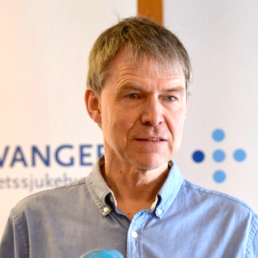
Siv Hilde Berg
Postdoktor (WP1)
PhD in health and medicine, Psychologist and safety scientist.

Marie Therese Shortt
Postdoktor (WP2)
Multimedia designer & lecturer, with PhD in visualising cross-cultural communication.

Daniel Adrian Lungu
Postdoctor (WP3)
Health Management researcher focused on improving the performance of healthcare organisations.

SHARE – Centre for Resilience in Healthcare
University of Stavanger
4036 Stavanger
Postboks 8600 Forus

